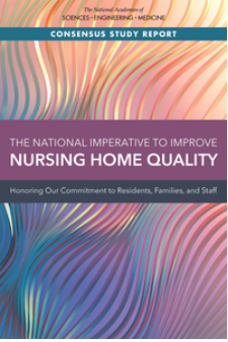Mary Madison, RN, RAC-CT, CDP
Clinical Consultant – Briggs Healthcare

“Nursing homes play a unique dual role in the long-term care continuum, serving as a place where people receive needed health care and a place they call home.
The 1986 Institute of Medicine report Improving the Quality of Care in Nursing Homes identified a range of challenges to the quality of care in nursing homes. While many important improvements have been made since the enactment of the Omnibus Budget Reconciliation Act of 1987, the provision of high-quality comprehensive care to all nursing home residents remains an elusive goal.
Ineffective responses to the complex challenges of nursing home care have resulted in a system that often fails to ensure the well-being and safety of nursing home residents—an unacceptable situation, documented by research, that has long been apparent to those who research, work in, or have loved ones in nursing homes.
The devastating impact of the COVID-19 pandemic on nursing home residents and staff has renewed attention to the long-standing weaknesses that impede the provision of high-quality nursing home care. In this context, with support from a coalition of sponsors, the National Academies of Sciences, Engineering, and Medicine (NASEM) formed the Committee on the Quality of Care in Nursing Homes to examine how the United States delivers, finances, regulates, and measures the quality of nursing home care.
The committee’s investigation led to several key conclusions about the current state of nursing home care, which does not align with the committee’s vision of high-quality nursing home care (see Box 1).
- The way in which the United States finances, delivers, and regulates care in nursing home settings is ineffective, inefficient, fragmented, and unsustainable.
- Immediate action to initiate fundamental change is necessary.
- Federal and state governments, nursing homes, providers, payers, researchers, and others need to make clear a shared commitment to the care of nursing home residents.
- Extreme care needs to be taken to ensure that quality improvement initiatives are implemented using strategies that do not exacerbate disparities in resources, quality of care, or resident outcomes.
- High-quality research is needed to advance the quality of care in nursing homes.
- The nursing home sector has suffered for many decades from underinvestment in ensuring the quality of care in nursing homes and a lack of accountability in how resources are allocated.
- All relevant federal agencies need to have authority and resources from the U.S. Congress to implement the recommendations of this report.
The committee identified seven broad goals, which provide the overarching framework for a comprehensive approach to improving the quality of care in nursing homes. The committee developed an interrelated set of recommendations to achieve each of these goals.”
- The Consensus Study Report Highlights can be viewed here.
- The slides for this webinar are found here. The recording will be posted to the NASEM Quality of Care in Nursing Homes website next week. This was an excellent overview of the NASEM’s Committee work.
- The Committee’s recommendations are available here.
- Purchase the book or download the free PDF (604) pages here.
Here’s an overview of the Table of Contents:
- Preface, Acronyms, Abstract, Summary
- Evolution and Landscape of NH Care in the U.S.
- Quality Measurement and Quality Improvement
- Care Delivery
- The NH Workforce
- NH Environment and Resident Safety
- Payment and Financing
- Quality Assurance: Oversight and Regulation
- Health Information Technology
- Recommendations
- Appendices
- Biographic Sketches
- Examples from the Initiative to Reduce Avoidable Hospitalizations Among Nursing Facility Residents
- Recommendations by Area of Measurement and by Area of Research
- Recommendations by Responsible Partners
- Recommendations Timeline
“The committee often reflected on the 1986 Institute of Medicine report Improving the Quality of Care in Nursing Homes, which was a critical milestone yet whose recommendations were not fully realized. As a nation we have made promises for better care in nursing homes, and those promises have not been kept. Our hope is that commitment and promises for quality nursing home care that were voiced throughout the pandemic will become promises kept. The recommendations from the committee are thoughtful and strategic. Perhaps the committees’ biggest challenges came when we tried to balance the need for very aggressive, overdue change with the reality of limited resources, competing priorities, and the complexity of systems change. We believe the recommendations in this report achieve that balance of what is possible and what is desperately needed.”
It’s important to note that the 1986 IOM report led directly to OBRA’87. For those of you who were not working in the LTC sector at that time (as I was), this was the 1st major overhaul of the NH industry and survey process. Now some 36 years later, this Committee’s report and recommendations will no doubt influence and/or steer a future overhaul of the NH industry.
